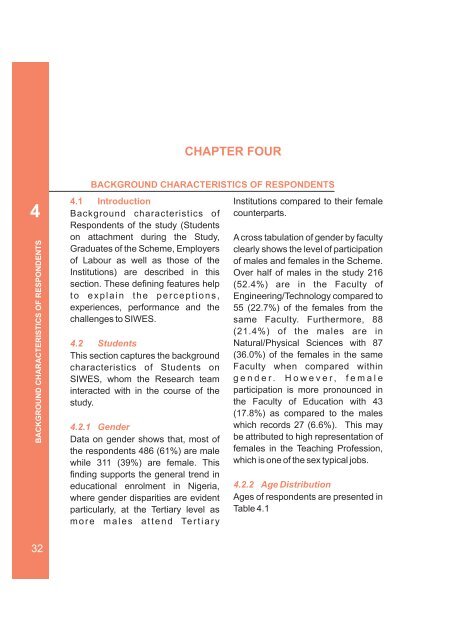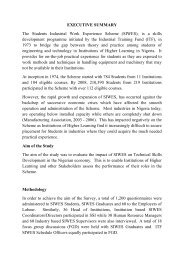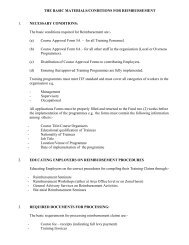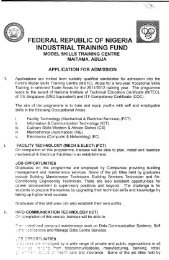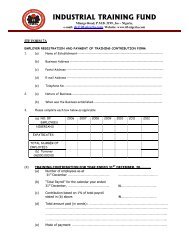5 - ITF Nigeria
5 - ITF Nigeria
5 - ITF Nigeria
Create successful ePaper yourself
Turn your PDF publications into a flip-book with our unique Google optimized e-Paper software.
CHAPTER FOUR<br />
4<br />
BACKGROUND CHARACTERISTICS OF RESPONDENTS<br />
BACKGROUND CHARACTERISTICS OF RESPONDENTS<br />
4.1 Introduction<br />
Institutions compared to their female<br />
Background characteristics of counterparts.<br />
Respondents of the study (Students<br />
on attachment during the Study, A cross tabulation of gender by faculty<br />
Graduates of the Scheme, Employers clearly shows the level of participation<br />
of Labour as well as those of the of males and females in the Scheme.<br />
Institutions) are described in this Over half of males in the study 216<br />
section. These defining features help (52.4%) are in the Faculty of<br />
t o e x p l a i n t h e p e r c e p t i o n s , Engineering/Technology compared to<br />
experiences, performance and the 55 (22.7%) of the females from the<br />
challenges to SIWES. same Faculty. Furthermore, 88<br />
4.2 Students<br />
(21.4%) of the males are in<br />
Natural/Physical Sciences with 87<br />
This section captures the background (36.0%) of the females in the same<br />
characteristics of Students on Faculty when compared within<br />
SIWES, whom the Research team g e n d e r . H o w e v e r , f e m a l e<br />
interacted with in the course of the participation is more pronounced in<br />
study.<br />
the Faculty of Education with 43<br />
(17.8%) as compared to the males<br />
4.2.1 Gender<br />
Data on gender shows that, most of<br />
which records 27 (6.6%). This may<br />
be attributed to high representation of<br />
the respondents 486 (61%) are male females in the Teaching Profession,<br />
while 311 (39%) are female. This which is one of the sex typical jobs.<br />
finding supports the general trend in<br />
educational enrolment in <strong>Nigeria</strong>,<br />
where gender disparities are evident<br />
4.2.2 Age Distribution<br />
Ages of respondents are presented in<br />
particularly, at the Tertiary level as Table 4.1<br />
m o r e m a l e s a t t e n d Te r t i a r y<br />
32


